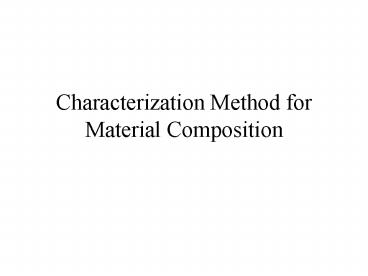Characterization Method for Material Composition PowerPoint PPT Presentation
1 / 26
Title: Characterization Method for Material Composition
1
Characterization Method for Material Composition
2
Outline
- X-ray Photoelectron Spectroscopy (XPS)
- Ultraviolet Photoelectron Spectroscopy (UPS)
- Auger electron spectroscopy (AES)
- Energy Dispersive X-ray Spectroscopy (EDX)
- Electron Energy Loss Spectroscopy (EELS)
3
Photoelectron Spectroscopy
4
X-ray Photoelectron Spectroscopy (XPS)
- 1967 Siegbahn Published comprehensive study on
XPS - 1969 Hewlett-Packard Produced the first
commercial monochromatic XPS instrument - 1981 Siegbahn received the Nobel Prize to
acknowledge his extensive efforts to develop XPS
into a useful analytical tool
Siegbahn
5
Components of an XPS system
- Basic components of a monochromatic XPS system
6
Application of XPS
- Elements that contaminate a surface
- Uniformity of elemental composition across the
top surface (aka, line profiling or mapping) - Uniformity of elemental composition as a function
of ion beam etching (aka, depth profiling)
7
Application of XPS
- Wide Scan Survey Spectrum for all elements
8
Application of XPS
- High Resolution Spectrum for Si (2p) signal
9
Ultraviolet Photoelectron Spectroscopy (UPS)
10
Auger electron spectroscopy (AES)
- 1920s Auger effect Lise Meitner and Pierre Auger
- 1960s Auger Electron Spectroscopy
11
Structure of AES
12
Specification of AES Samples
- Size
- No larger than about 18 mm x 12 mm.Height
should not exceed 12 mm. - Conductivity
- Must be conductive or area of interest must
be grounded properly. Insulating samples
including thick insulating films (gt3000 Å) cannot
be analyzed. - Compatibility
- Must be compatible with high vacuum
environment (lt1x10-9 Torr).
13
Application of AES
- Survey scan
- Multiplex scan
- Mapping
- Depth profile
14
Application of AES
- Particle identification
- Passive oxide film thickness
- Contact pad contamination on integrated circuits
- Quantifying light element impurities
- Mapping spatial distribution of surface
constituents
15
Application of AES
- AES survey spectrum for passivated stainless
steel
16
Application of AES
- Scanning Auger microscopy depth profile of
passivated stainless steel
17
Energy Dispersive X-ray Spectroscopy (EDX)
- A chemical microanalysis technique
- Performing in conjunction with a SEM
- Utilizing x-rays emitted from the sample during
bombardment by the electron beam to characterize
the elemental composition of the analyzed volume - Features or phases as small as about 1µm can be
analyzed
18
Principle Structure of EDX
19
Application of EDX
- Surface contamination analysis
- Corrosion evaluations
- Coating composition analysis
- Rapid material alloy identification
- Small component material analysis
- Phase identification and distribution
20
Application of EDX
- Typical EDS spectrum
21
Comparison of AES and EDX Analysis Volume
Capability
- AES is more sensitive than XPS.
- AES can be complement of XPS.
22
Electron Energy Loss Spectroscopy (EELS)
A technique for studying atoms, molecules, or
solids in which a substance is bombarded with
monochromatic electrons, and the energies of
scattered electrons are measured to determine the
distribution of energy loss, which is known as
Electron Energy Loss Spectroscopy or EELS
Developed in 1940s by James Hillier
23
Principle of EELS
24
Principle Application of EELS
- The energy loss spectrum can be displayed and the
loss profiles be used to identify elements in a
specimen.
25
Pro Con of EELS
- Advantages
- Elemental Analysis
- Elemental Imaging and Mapping
- Improved contrast without loss of resolution
- Thick specimen imaging
- Disadvantages
- Elemental analysis requires very thin specimens
(10-20nm)
26
Comparisons of EELS and EDS
- 1). EELS has higher spatial resolution than EDS.
- EDAX may be affected by backscattering
electron, - And fast secondary electron within the sample.
- 2). EELS has higher energy resolution than EDS.
(around 1 eV) - 3). EELS is better in detecting light element.
- 4). EELS contains information of electronic
structure. - 5). EDS is easy to operate and quick for a
qualitative composition analysis.
However, EELS Spectra from thick specimens
(gt50nm) may be difficult to interpret because of
plural scattering. Interpretation of fine
structure sometimes requires sophisticated
calculations.

